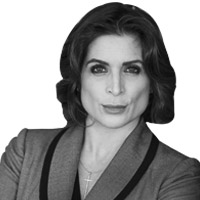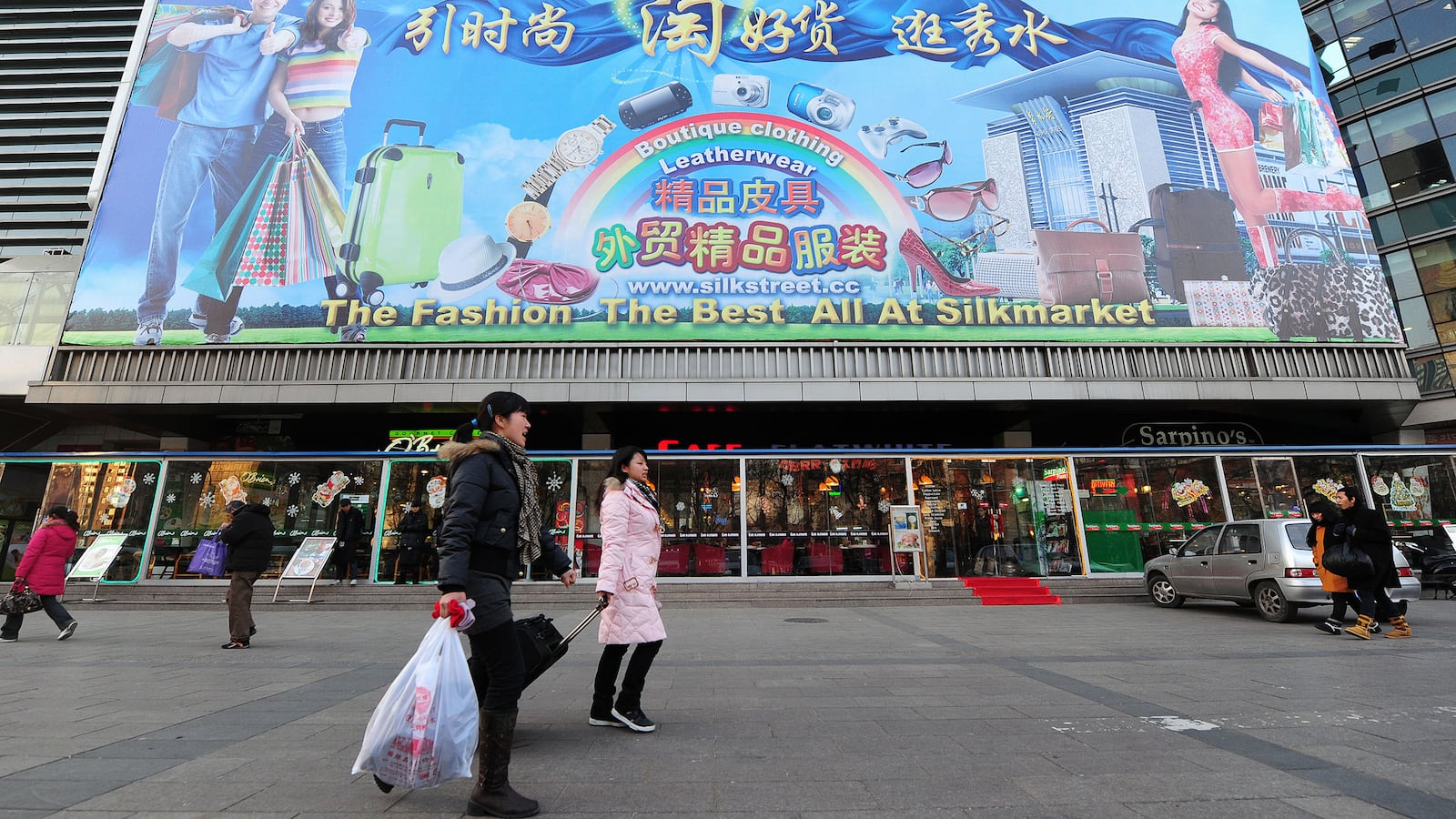Beijing’s Silk Road market peddles much more than Louis Vuitton knock-offs, and it’s only the retail arm of China’s vast, billion-dollar counterfeiting empire.
While the tourists wonder at Chinese history—from the boisterous to the cleansed, from the imperial to the Communist—they also consume another Chinese claim to fame: counterfeiting of Western products. China’s consumption of Western intellectual property has been ravenous, as any manufacturer (not just of luxury goods) can tell you. From Louis Vuitton handbags to Apple chargers to Viagra, it is all counterfeited in China. According to the Organization for Economic Co-operation and Development (and anyone else who hasn’t been living under a rock), China is the number one source of counterfeited goods.
Behemoth Chinese online retailer Alibaba may have undertaken measures to clean up its act since it floated its shares on the New York Stock Exchange, but in Beijing there remains the Silk Road market: a whole shopping mall full of counterfeits, from the luxurious to the mundane.
The Silk Road market is a five-story, all-counterfeit shopping center featured in “Best of Beijing” lists on websites, including TripAdvisor. It has learned some things the hard way, though: you can tell which companies are the most aggressive in pursuing copyright infringement, because those are the products for which you have to ask. I walked through every floor. Tory Burch and Chanel shoes were mixed in with frankly fake Rolexes. But I felt like I hadn’t hit pay dirt yet, like I was missing something. I went in search of expensive luggage and handbags. Louis Vuitton and Hermès were the real prizes.
I knew women on New York’s Park Avenue and London’s Mayfair who bought fake Hermès from other genteel women who sold them out of their apartments. They even ranked them by quality of copy. A good fake Birkin went in New York for about $1,000—much cheaper than the $15,000 often paid for the real thing, if you were lucky enough to get off the waiting list. If Londoners and New Yorkers were getting them from here, and I was in the epicenter of counterfeiting, I was sure I could find the source if I pressed hard enough. I browsed nonchalantly through one more upscale luggage vendor and opened with a slightly easier target.
“Have anything more interesting?”
“What you want?”
“Louis Vuitton.”
The woman looked me over suspiciously. She glanced around the tiny shop to make sure no one else had entered. She stepped outside the door to scan for anyone who might be within earshot. Then she came back to me.
“Follow me.”
She opened a door in the back of the shop and shut it behind me promptly. There were lots of LV-emblazoned suitcases, handbags, wallets, and cosmetic cases, some of them wrapped in clear plastic.
“We careful. Louis Vuitton. They send spies and they sue. So we hide.”
I nodded and looked around.
“Tell no one. What you want?”
I felt like an undercover DEA agent doing a drug buy. “A carry-on. Small suitcase.”
She showed me several. She explained that the better ones came with the logo-stamped locks and keys, and she showed me the certificate of authenticity inside.
“Better. No difference. More money.”
Judging by the relative fluency of her English, she likely did this negotiation a lot, covert or not. She wanted around $600. I haggled with her, then thanked her for her time, saying I would think about it, and walked away. I was intrigued that this was so easy.
The next day, I hired a guide and driver to take me out to the Great Wall of China. In fit shape, I trekked high and far, but what I was seeing for myself was only a minuscule fraction of the huge snaking structure that can be seen from space. The counterfeits remained on my mind, though. Descending from the Wall, I asked my guide (who had waited in the car) if she knew where one could buy counterfeit Hermès Birkin bags.
“Yes. I know the best.” Lily’s English was perfectly fluent. Her other job was as an interpreter.
We drove back into central Beijing, just a few blocks from my counterfeit shopping mall of the day before, to a business known as “Jinyie Xi Li.” The car wound its way through low buildings toward the back of a warehouse. It stopped at the top of the alley-way, and we got out to walk the rest of the way.
“You’re from New York?” Lily asked.
“Yes. How can you tell?”
“You walk fast. People from New York always walk faster than any other American.”
“That’s true. We are always in a hurry,” I agreed.
Ascending some small metal steps, Lily pressed a buzzer next to a small metal door. A voice on an intercom under a camera answered. They spoke in Mandarin, and the door was buzzed open. Inside there was a glass-enclosed window, with a man behind it. Lily approached the man, provided some sort of identification, and spoke more Mandarin, gesturing to me, presumably explaining I was a client. He emerged and unlocked another metal door.
Behind that door, there were rows and rows of Hermès Birkin bags, the non plus ultra status symbol of New York society mavens. They were stacked on shelves, floor to ceiling; they covered the walls. I gasped. I was in the presence of many millions of dollars’ worth of counterfeit handbags: a supermarket of counterfeits, in effect. I had Hermès bags at home; these were indistinguishable, right down to the locks, logos, keys, and certificates of authenticity. Their biggest size Birkins sold for $500. So many women back home would have wet themselves with excitement and willingly scooped up several of them.
Counterfeiting luxury goods is big business. Based on World Customs Organization data, the OECD estimates that in 2013, counterfeit goods accounted for up to 5 percent of imports into the EU, making that trade alone worth 85 billion euros. This is a rising threat in a global economy whose value generation is increasingly driven by intellectual property. And the marketers are savvy: like any well-run business, the counterfeiters target consumers across market segments. The primary market segment is buyers who think they are buying a real car part, a real iPhone charger, a real medicine, and are surprised when they don’t work or (in the case of car parts or medicines) cause serious harm or death.
The second market segment is represented by my fake Birkin- and Louis Vuitton-buying buddies: The consumers are aware, but think there is no harm being done. The only harm, in their view, is to some major corporation that is overcharging anyway, to pay for all that marketing in glossy magazines and the rent on all those beautiful boutiques sitting on prime real estate. Buying the fake Louis Vuitton or Hermès is, in that construct, a victory for the little guy, against corporate greed.
In our March 2016 newsletter, my company, Asymmetrica, featured an analysis of this pattern of consumption. A study conducted by Paris-Sorbonne University Abu Dhabi analyzed why people who can afford genuine luxury goods persist in buying counterfeits. The results reveal the psychological drivers that effective strategic messaging must address if luxury goods producers wish to protect the integrity of their brands, and if law enforcement hopes to stymie illicit financial flows to transnational criminal organizations. In short, the wealthy Emiratis (like those on Mayfair and Park Avenue) buy genuine goods for high-profile events with wealthy peers who will spot the difference; they buy counterfeits for everyday wear-and-tear.
A third market segment is the aspirational middle class, who can afford the occasional $500-$1,000 bag but not the $15,000 bag. Interestingly, when top brands come out with limited editions, they are subject to another phenomenon involving the knowing counterfeit consumer: the fashionista. She wants to be on trend, but knows another trend will replace it next season, so is not willing to (or cannot afford to) invest the money on staying on trend season after season. Furthermore, counterfeits of high-profile but limited-edition goods are the easiest to get away with: not enough people will know the details to spot the difference. In short, the only effective deterrent to buying counterfeit goods is shame: embarrassment among one’s social peers.
There is plenty of reason for shame. This massive illicit trade transits through the same main hubs as legitimate trade: Hong Kong, China, Singapore, Panama. The large shipments are then broken down in safe havens such as free trade zones, which have lax enforcement, and get sent out from there in small-parcel shipments, through the mail or UPS, creating a huge enforcement headache for private shippers and law enforcement. Other transit points, which we know all too well at Asymmetrica, are chosen—places where there is weak governance or weak enforcement capacity.
More darkly, counterfeiters also use routes and transit points where there is a strong presence of criminal or terrorist networks, funding serious violence as these handbags move along their routes to the consumer. The production and distribution are heavily controlled by ultraviolent Chinese triads, which, in their diversified criminal portfolios, also traffic in narcotics and women bound for prostitution. The problem is, the society women don’t know they are carrying “blood handbags”; if they did, they might think twice before buying them, either on the sidewalks of Lexington Avenue or in the genteel drawing rooms of Park Avenue.
The answer lies in making this illicit business bad business. In December 2015, the U.S. Trade Representative (USTR) gave a very stern warning to Chinese online retail behemoth Alibaba (which is much bigger than Amazon) about the sale of pirated and counterfeit products on its online platforms. The USTR very nearly put Alibaba’s Taobao marketplace (a Chinese online shopping website similar to eBay and Amazon) and Alibaba.com back on the Notorious Markets List, from which Alibaba.com was removed in 2011 and Taobao in 2012. The USTR has been pressured to relist them as Notorious Markets after complaints from various intellectual property rights holders’ associations.
The USTR report stated: “The internet traders who use these online markets to offer counterfeit goods are difficult to investigate and contribute to the growth of global counterfeiting.” A re-listing as a Notorious Market would adversely affect the Alibaba group, which is now listed on the New York Stock Exchange and is in the midst of complex negotiations with more rights holders, including Disney. Both the stock price and the negotiations would be severely damaged by blacklisting.
Within days of the USTR’s threat to list Alibaba as a Notorious Market, Alibaba Group Holding Ltd. announced it had hired Matthew Bassiur as vice president, head of global intellectual property enforcement, to reduce the prevalence of counterfeits on its Alibaba and Taobao platforms, which is costing the firm heavily in lost licenses, lawsuits, and fines. Bassiur previously oversaw anti-counterfeiting for Pfizer Inc. and Apple Inc., and prior to those private sector positions was a federal prosecutor for the U.S. Department of Justice.
Whether Bassiur sticks to his enforcement roots and cleans up Alibaba or simply becomes a front man, only time will tell, but other online sites are worried about the trouble counterfeits bring. Google had similar concerns about impact to its revenue stream, and on January 22, 2016, it was announced that the company had hired more than a thousand people dedicated to removing advertising of counterfeits (particularly pharmaceuticals) and other scams, such as phishing and malware. Google claimed its staff removed over 780 million “bad ads” and suspended more than 30,000 websites in 2015.
Excerpted from Blood Profits: How American Consumers Unwittingly Fund Terrorists by Dr. Vanessa Neumann. Copyright 2017 by Dr. Vanessa Neumann. Published by St. Martin’s Press.






